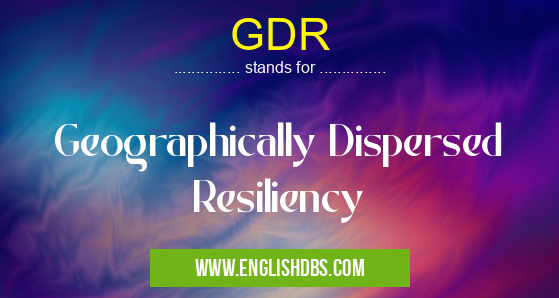What does GDR mean in UNCLASSIFIED
GDR stands for Geographically Dispersed Resiliency, a term used in the Information Technology (IT) industry to describe a strategy of spreading IT resources across multiple regional locations. This approach is designed to ensure that if one location experiences an outage or other major disruption, the services provided by that location can be quickly picked up from another site. By utilizing multiple geographically dispersed sites, organizations are better able to guarantee the continued availability of their applications and services regardless of unforeseen circumstances.

GDR meaning in Unclassified in Miscellaneous
GDR mostly used in an acronym Unclassified in Category Miscellaneous that means Geographically Dispersed Resiliency
Shorthand: GDR,
Full Form: Geographically Dispersed Resiliency
For more information of "Geographically Dispersed Resiliency", see the section below.
Advantages
The advantages of GDR over traditional single-site architectures are numerous. This strategy increases redundancy and resiliency by providing backup sites that are automatically capable of taking over operations in case there is an outage or other issue with the primary site. Additionally, this method also has the potential to reduce overall costs due to economies of scale and improved infrastructure utilization rates as well as increased flexibility when responding to opportunities as they arise. Finally, GDR offers a more secure architecture than its single-site counterpart since it reduces reliance on any single point and makes it more difficult for attackers to compromise sensitive data stored in multiple parts of the world simultaneously.
Essential Questions and Answers on Geographically Dispersed Resiliency in "MISCELLANEOUS»UNFILED"
What is Geographically Dispersed Resiliency?
Geographically Dispersed Resiliency (GDR) is the practice of spreading out resources across multiple sites so that infrastructure components are distributed in separate, physically isolated locations. This helps to ensure that the system remains resilient and secure in case of any disruption or disaster.
How does GDR work?
GDR works by distributing resources across multiple sites, which can include different physical locations, cloud infrastructures, or logical networks. By distributing these elements in separate physical locations, an organization can benefit from increased uptime and greater data protection against environmental hazards or malicious attacks.
What are the benefits of GDR?
The main benefits of GDR include increased availability and business continuity, improved data protection and security, enhanced scalability and flexibility to accommodate changing needs, as well as reduced costs associated with building redundant systems. With GDR, organizations also get the advantage of reduced risk from a single point-of-failure due to its geographically dispersed nature.
Why is it important for businesses to have a GDR strategy?
A good GDR strategy can provide businesses with greater resilience in the face of potential disruptions from natural disasters, malicious attacks or accidental outages. With GDR in place, businesses can keep their critical systems running at optimal performance despite any external factors. Additionally, having a comprehensive plan for managing your dispersed infrastructure is essential for long-term success.
What's involved in implementing a GDR strategy?
To successfully implement a GDR strategy there needs to be careful consideration around aspects such as technology selection and placement; network connectivity and access control; policy development; system operations; backup/recovery procedures; budget management; personnel training and monitoring/maintenance plans. Once all these components have been put into place, organizations will benefit from greater resiliency against potential threats.
Are there certain scenarios where GDR strategies are advantageous?
Geographically Dispersed Resilience strategies are particularly beneficial for organizations located in areas prone to natural disasters such as hurricanes or floods that could lead to catastrophic outages — having multiple sites located far away from each other helps eliminate this risk significantly. Additionally, businesses operating across multiple countries/regions benefit from having different components spread over different jurisdictions as this offers an extra layer of security.
Is there anything else I should consider when creating my own GDR plan?
In addition to technical considerations such as redundancy or load balancing, it's important to take into account the legal and regulatory issues associated with data sovereignty when creating your own plan. Different regions may have their own local laws governing how data must be stored/processed - making sure you comply with these regulations is essential for successful deployment.
Final Words:
In summary, GDR is an important strategy for ensuring system reliability and security in today's competitive business landscape. By leveraging multiple geographically dispersed facilities, organizations are able to increase redundancy and resiliency while decreasing operational costs and risk exposure making them more competitive in both local and global markets alike.
GDR also stands for: |
|
| All stands for GDR |
